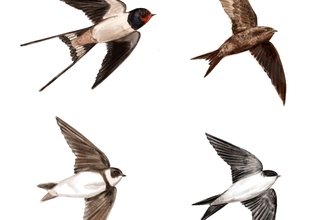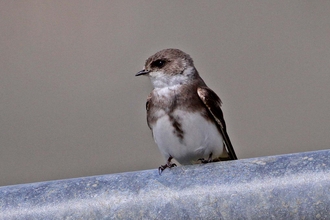What are swallows and house martins?
Swallows and house martins (and the less commonly seen sand martin) are birds that have perfectly adapted to living life on the wing. They are aerial experts and their long, pointed wings enable them to soar effortlessly, while giving them an ability to change direction efficiently at high speeds when hunting airborne insects.
To tell a swallow from a martin in flight, the tail in the best giveaway: a swallow's forked tail is longer and more tapered than a martin's tail. Swallows also have a distinctive red patch on their chin, which is visible when they are lined up perching on telephone cables (something a house martin is very unlikely to do). Despite being similar in appearance to swifts, they aren't related to them in any way...swifts are actually more closely related to hummingbirds.
They symbolise the summer perfectly, timing their arrival in the UK with the improvement in weather. For centuries, swallows and house martins have adapted to living in close proximity to humans and have been tolerated in urban areas, not just for their welcome sight and calls, but also for their ability to hunt insects, particularly mosquitoes from dawn until dusk. They come to British shores to breed and rear their young after migrations of 1000s of miles from north and central Africa. Populations of these aerial acrobats have plummeted in recent years, due to a combination of factors, from loss of former colony locations to a crash in insect numbers globally. However, there are international efforts to help stablilise the numbers before they disappear completely.
Colony life
Swallows and both types of martins tend to live in busy colonies, where it is definitely a case of safety in numbers. House martins are associated with nesting in the eaves of buildings, but their cousins, sand martins prefer to nest in sandy cliffs, where they nest in precarious tunnels. Swallows are often referred to as barn swallows, due their preference for building nests in barns and old farm buildings.
All three species are prey to other wildlife; falcons can easily match their acrobatics and catch them in mid-air and stoats and weasels will happily scale the wall of a barn to raid nests. By nesting and living in numbers, each individual bird gives itself less chance of being attacked.
Pre-migration time
By September, the breeding season is complete and young birds have spent their first two months on the wing developing wing strength and building the energy to begin their flight south to a warmer climate for the winter.
The first sign that they are getting ready to leave their breeding grounds is the gathering crowds of birds circling in the sky. Swallows are regularly seen perched high on phone cables, taking a rest in between flights for food. As the weather begins to cool down, the birds then leave with little fanfare, heading straight south, over the channel into France, then onward to north Africa where they fly right over the Sahara Desert. Some swallows and martins are known to travel over 3000 miles!
Once they have left the UK, the skies can seem very quiet. Fewer and fewer birds are surviving their long distant flights and sadly, in many areas of the country, the sky remains quiet even in spring when the swallows are due to return. Like the swifts and other migratory birds, swallows and house martins need a plentiful supply of insects when they finally make it back to the UK. So, one of the best ways to help them is to create more insect-friendly areas, full of wild flowers and grasses. Why not spend some time this winter making your garden or local greenspaces havens for insects and help ensure there is plenty of food for our high flying birds during their summer in the British Isles.








